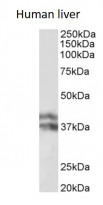ARG59690
anti-Haptoglobin antibody
anti-Haptoglobin antibody for Western blot and Human,Pig
Overview
| Product Description | Goat Polyclonal antibody recognizes Haptoglobin |
|---|---|
| Tested Reactivity | Hu, Pig |
| Predict Reactivity | Dog |
| Tested Application | WB |
| Host | Goat |
| Clonality | Polyclonal |
| Isotype | IgG |
| Target Name | Haptoglobin |
| Antigen Species | Human |
| Immunogen | Synthetic peptide around the internal region of Human Haptoglobin. (NP_005134.1; NP_001119574.1, C-STVPEKKTPKSP) |
| Conjugation | Un-conjugated |
| Alternate Names | HPA1S; Haptoglobin; BP; HP2ALPHA2; Zonulin |
Application Instructions
| Application Suggestion |
|
||||
|---|---|---|---|---|---|
| Application Note | WB: Recommend incubate at RT for 1h. * The dilutions indicate recommended starting dilutions and the optimal dilutions or concentrations should be determined by the scientist. |
||||
| Observed Size | 37, 40 kDa (Human), 40 kDa (Pig) |
Properties
| Form | Liquid |
|---|---|
| Purification | Affinity purified |
| Buffer | Tris saline (pH 7.3), 0.02% Sodium azide and 0.5% BSA. |
| Preservative | 0.02% Sodium azide |
| Stabilizer | 0.5% BSA |
| Concentration | 0.5 mg/ml |
| Storage Instruction | For continuous use, store undiluted antibody at 2-8°C for up to a week. For long-term storage, aliquot and store at -20°C or below. Storage in frost free freezers is not recommended. Avoid repeated freeze/thaw cycles. Suggest spin the vial prior to opening. The antibody solution should be gently mixed before use. |
| Note | For laboratory research only, not for drug, diagnostic or other use. |
Bioinformation
| Database Links | |
|---|---|
| Gene Symbol | HP |
| Gene Full Name | haptoglobin |
| Background | This gene encodes a preproprotein, which is processed to yield both alpha and beta chains, which subsequently combine as a tetramer to produce haptoglobin. Haptoglobin functions to bind free plasma hemoglobin, which allows degradative enzymes to gain access to the hemoglobin, while at the same time preventing loss of iron through the kidneys and protecting the kidneys from damage by hemoglobin. Mutations in this gene and/or its regulatory regions cause ahaptoglobinemia or hypohaptoglobinemia. This gene has also been linked to diabetic nephropathy, the incidence of coronary artery disease in type 1 diabetes, Crohn's disease, inflammatory disease behavior, primary sclerosing cholangitis, susceptibility to idiopathic Parkinson's disease, and a reduced incidence of Plasmodium falciparum malaria. The protein encoded also exhibits antimicrobial activity against bacteria. A similar duplicated gene is located next to this gene on chromosome 16. Multiple transcript variants encoding different isoforms have been found for this gene. [provided by RefSeq, Oct 2014] |
| Function | As a result of hemolysis, hemoglobin is found to accumulate in the kidney and is secreted in the urine. Haptoglobin captures, and combines with free plasma hemoglobin to allow hepatic recycling of heme iron and to prevent kidney damage. Haptoglobin also acts as an Antimicrobial; Antioxidant, has antibacterial activity and plays a role in modulating many aspects of the acute phase response. Hemoglobin/haptoglobin complexes are rapidely cleared by the macrophage CD163 scavenger receptor expressed on the surface of liver Kupfer cells through an endocytic lysosomal degradation pathway. Uncleaved haptoglogin, also known as zonulin, plays a role in intestinal permeability, allowing intercellular tight junction disassembly, and controlling the equilibrium between tolerance and immunity to non-self antigens. [UniProt] |
| Cellular Localization | Secreted. [UniProt] |
| Calculated MW | 45.2 kDa (NP_005134.1); 38.5 kDa (NP_001119574.1) |
Images (2) Click the Picture to Zoom In
-
ARG59690 anti-Haptoglobin antibody WB image
Western blot: 35 µg of Human liver lysate (in RIPA buffer) stained with ARG59690 anti-Haptoglobin antibody at 0.1 µg/ml dilution and incubated at RT for 1 hour.
-
ARG59690 anti-Haptoglobin antibody WB image
Western blot: 35 µg of Pig liver lysate (in RIPA buffer) stained with ARG59690 anti-Haptoglobin antibody at 1 µg/ml dilution and incubated at RT for 1 hour.







